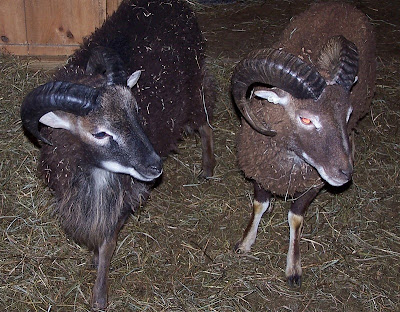I think that now is a good time to explain to people what exactly all of our livestock is, what makes them special, and why we keep them. Soay sheep are our primary focus, so we'll cover the basics on them first...
Soay sheep (in N.A., the pronunciation is pretty loose, from so-ay to so-eye to soy; so-eye is generally considered to be the proper pronunciation, since it most closely resembles the Norse that the word is derived from, but we tend towards so-ay - it seems more American) are a primitive breed of sheep, believed to be the oldest breed of "domestic" sheep. I use the " " on "domestic", because these are far from your modern, domestic breeds of sheep. Soays are beautiful and graceful, intelligent and wary, truly hardy and resilient. The trust of a Soay is earned over time, and we cherish every bit that we receive.
Adult ewes average about 55 pounds, and adult rams about 65 pounds. Ewes can be horned, scurred (small, under-formed horns), or polled (no horns). Rams are almost always horned with beautiful, large, tight, spiral horns that resemble a Bighorn sheep, but, very rarely, scurred rams do occur.
Colors typically range from light brown ("light phase" or "tan", genetically recessive) to dark brown (standard, genetically dominant). The tans I call "brown-based" because the base of the coat is brown and the exposed skin tends to be brown to pink. Standard I refer to as "black-based" since the base of the coat and exposed skin is black. The normal pattern is Mouflon, a "wild" pattern that produces lighter markings (typically a cream to white color) on the face around the eyes and under the jaw, on the legs, under and around the tail, and the entire underbelly. Recessive to this is self-coloration, which, when expressed, eliminates the Mouflon pattern and causes the "base" color to show true, i.e. black-based animals appear entirely black, and brown-based animals appear entirely chocolate brown. Spotting, probably more accurately called "pied", produces white patches of varying sizes and shapes, typically starting at the poll (top of the head between the horns) as a small spot and increasing in size on some animals, to white on the feet, and lastly, in rarer instances, random white patches on the body.
Here's a standard mouflon ram (Cedrus - 62.5% British) with an average horn-set at 10mo:
This also gives a good view of a ram's beard during rut - Cedrus's is particularly dramatic!
Here's a nifty comparison between Cedrus & Royton (tan, 100% British, 2yo):
The similarities are almost as striking as the differences! The colors really jump out at you, but notice the similarities in the patterning on the faces? How about the fact that Royton has almost no beard? How about how Cedrus's horns are black and Royton's are brown?
Here's a wonderfully spotted ewe lamb, Dicentra (tan spotted, 62.5% British), from this year (2012) at ~3mo:
And a closeup of those awesome horns!
Here's a different look entirely! Tegan is 100% British and she's tan (about 2mo here), but what's up with her patterning?
I'm simply nuts about this variation that's come over from the UK in recent years! I'm considering borrowing from the Shetland theme and calling this "bandet mouflon" (a variation on "bandit"), since this pattern typically looks like a mask or goggles. Tegan's mother, Mattishall, has the same look, except she's standard, and she's my favorite ewe! Here's a quick look at Matti when she was about 6mo:
Here's Ribbon (standard self-colored, possibly spotted, 50% British, ~5mo) he has a poll spot that may or may not indicate that he is spotted. We're in discussions about what constitutes actual spotting, what 'amount' of a poll spot may be an indicator of carrying spotting, and what is simply just an anomaly that has no genetic significance. (This is something that we consider fun around the homestead! We track all sorts of lamb data, lose sleep over the construction of breeding groups, calculate genotypes, all sorts of cool stuff!) Anyhoo, here's Ribbon, as promised:
Here's a side-by-side of two different sized poll-spots that we document as "twinks" when the lambs are born:
That's Corydalis (56.25% British, ~3 days old) and Ostrya (tan, 81.25% British, ~2 hours old). Cory is out of Ribbon x Betula, and Ostrya is out of Amado x Susan (Amado is also the sire of Dicentra, at the beginning of this post, with the definite, large spot.) Ostrya is 2yo now and her twink is still barely visible. Cory's spot will be visible for his whole life.
Something that I haven't covered in this basics is the distinction between British Soays, North American Soays, and percent British Soays. In a future post I'll stick my neck out and tackle that topic; it will consist of some factual information and a lot of conjecture and opinion. This can be a very touchy subject amongst Soay people and I just don't think that it should be; we keep both and they each serve similar but distinct purposes on our homestead. Either way, they're blast to keep and raise!












